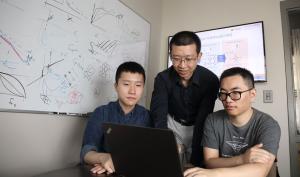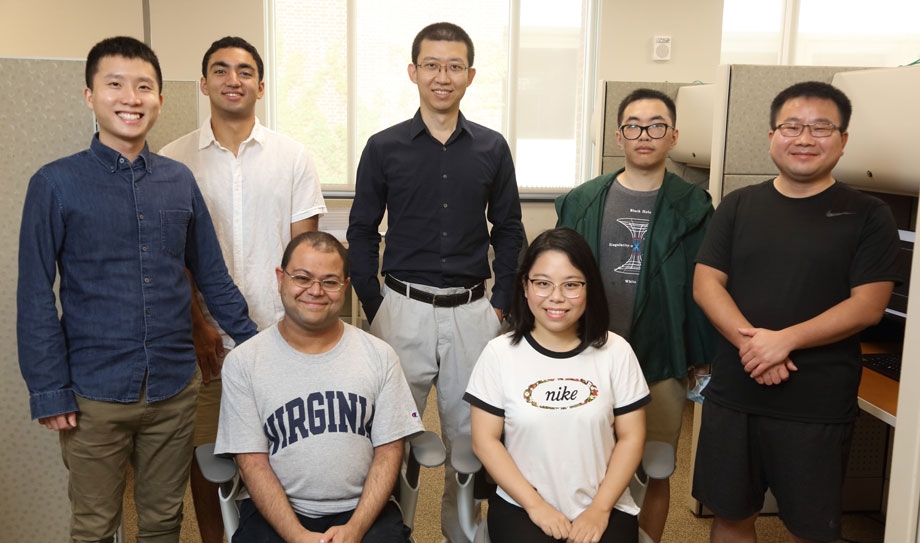
Welcome to the modern age of materials, where complex alloys lighten the weight of cars and planes to save fuel and help the environment, biomaterials replace human joints so we can remain active into our elder years, and graphene-coated smart screens put us in touch—literally—with individual creativity and global commerce.
These breakthroughs demonstrate the power of nanotechnology, a term introduced in 1974 to describe the precision machining of materials to the atomic scale. While experimentation, development and commercialization of nanomaterials has evolved, the textbook model describing how and when a material changes its form remains stuck in the 1970s.
Bi-Cheng Zhou, assistant professor of materials science and engineering at the University of Virginia School of Engineering, has a plan to bring this model into the modern age, democratizing materials design in the process.
Zhou has earned the prestigious National Science Foundation CAREER Award to innovate a valuable tool in alloy development called the CALPHAD method. It stands for CALculation of PHAse Diagrams.
We intuitively know that materials go through phases to change form. Water, for example, can change from a liquid to its solid form as ice or its vapor form as steam. CALPHAD is a more specialized method widely used by materials scientists and engineers in universities and industry to predict a material’s stable form under different conditions, as represented by the phase diagrams.
Zhou aims to put the power of CALPHAD into the hands of materials scientists who are working with complex concentrated alloys and composite materials, overcoming a serious limitation of the existing computational model. Whereas typical metal alloys comprise one or two major elements with smaller amounts of other elements, complex concentrated alloys, sometimes called high-entropy alloys, represent a near equal mix of many different atoms, which poses challenges to the CALPHAD method.
“It was previously thought that these atoms were randomly distributed in the material, but more and more research reveal that’s not the case. An atom prefers to bond with other specific kinds of atoms in its neighborhood,” Zhou said.
The existing CALPHAD method cannot describe this so-called short-range order in materials, which seriously limits the method’s usefulness in meeting materials challenges such as exploring nano-scale clusters (i.e., short-range order) to enhance the strength of alloys and predicting properties of material interfaces. Zhou will capture this preferential behavior in a new thermodynamic model integrated with the CALPHAD framework.
“We can tune the short-range order by changing processing parameters such as temperature and chemical composition, opening new doors for materials discovery,” Zhou said. “I want to give my colleagues more freedom to improve materials properties, not just mechanical properties, but corrosion resistance, catalysis and thermoelectric properties as well.”
Zhou’s physics-based approach to computational materials promises a deeper understanding of materials’ equilibrium structure under any given condition. “My thermodynamic model will make CALPHAD applicable to any kind of complex concentrated alloy you can imagine,” Zhou said.
Zhou began to delve into CALPHAD as a doctoral student of Zi-Kui Liu, professor of materials science and engineering at Pennsylvania State University. Liu serves as editor-in-chief of the CALPHAD Journal, the International Research Journal for Calculation of Phase Diagrams. Zhou’s collaboration with Liu offered first-hand experience with CALPHAD’s advantages and shortcomings.
“CALPHAD branches out to industry as well as academe; it’s practicality is a big advantage,” Zhou said. “As a researcher, I wanted to expand CALPHAD’s ability to explain material behavior without sacrificing the functionality and efficiency that makes it so attractive in product development.”
Zhou pursued this ambition when he was a post-doctoral researcher with Chris Wolverton, Jerome B. Cohen Professor of Materials Science and Engineering at Northwestern University. Zhou immersed himself in computational materials science, specifically first-principles quantum mechanical simulation tools.
“Working in Chris’ group, I gained deep insight and practice in the physics way of doing things,” Zhou said.
Zhou merged the CALPHAD method with first principles theories to create a hybrid that is practical, with sound physics behind it. This not only brings more physics into CALPHAD but also introduces a new paradigm of thermodynamic modeling that enables atomic-scale order to be exploited as a new dimension for materials design. Reflecting this duality of theory and practice, Zhou’s CAREER Award is jointly sponsored by two National Science Foundation programs, Metals and Metal Nanostructure and Condensed Matter and Materials Theory.
Zhou’s thermodynamic model will find immediate application in complex concentrated alloys, and he anticipates extending the model from metals to oxides. This move, at the nexus of corrosion and structural materials research, leverages two strengths of UVA Engineering’s Department of Materials Science and Engineering.
With professor John R. Scully, Charles Henderson Chaired Professor of Materials Science and Engineering, Zhou has a unique opportunity to apply his thermodynamic and kinetic modeling to corrosion.
Many of the metals in use today do not corrode because they have a protective oxide layer or scale. Acidity, temperature and the metals’ electro-chemical potential are variables that can change the content of the oxides in the protective scale, making the metal susceptible to corrosion. Degradation may be calculated with an electrochemical phase diagram, which is reliable for pure metals such as copper or iron, but not novel alloys. Zhou’s thermodynamic modeling accounts for alloys that mix metal ions in oxide layers.
In a paper co-authored with Scully published in npj Materials Degradation, Zhou accurately explains how complex metal alloys corrode when immersed in water, providing invaluable information about these alloys’ resistance to aqueous corrosion under various electric potential and acidic conditions. Other researchers can use Zhou’s computational tool to predict which oxides will form under which conditions. Zhou published the open code, which any researcher can apply to his or her own database to calculate any electrochemical diagram of interest.
Extending this research from thermodynamics to kinetics, Zhou is developing a computational modeling tool based on nonequilibrium thermodynamics to predict the rate at which the oxide layer breaks down and corrosion occurs.
Additionally, Zhou has joined a multi-university team led by Elizabeth J. Opila, professor of materials science and engineering and director of the Rolls-Royce University Technology Center on Advanced Material Systems at UVA Engineering. They aim to develop a coating that will enable a refractory alloy to perform at 1800 ºC (3272 ºF), which can be used at the leading edge in hypersonics. Refractory alloys contain high chromium levels and strengthening elements to increase their mechanical properties at high temperatures.
Opila’s team will design the coating made with an equal or a relatively large proportion of five or more rare-earth elements in the oxide. Zhou’s job is to make sure coatings are chemically compatible with the niobium alloy they are designed to protect. Zhou will also draw on his expertise in computational thermodynamics and kinetics of materials to reduce oxygen transport, such that oxidation slows down over time as the oxide layer thickens.
“I am grateful to Dr. Scully and Dr. Opila for inviting me to join their multi-university teams. My colleagues’ proactive interest in my work and the synergistic aspect of the department’s research made UVA my first and only choice for a permanent home in academe,” Zhou said.

The five-year NSF CAREER Award will enable Zhou to welcome more graduate students to his computational thermodynamics and kinetics of materials research group and to introduce his work to an interdisciplinary group of graduate and undergraduate students. He is developing a new course that takes students on a deep dive into thermodynamic modeling and encourages them to adopt the CALPHAD method in their own research. He is also partnering with the Virginia-North Carolina Alliance to recruit undergraduate students from minority and underserved communities to participate in a summer research-study program.
“Thermodynamics is an exciting subject; we need to make it more accessible and less abstract,” Zhou said.
To reach materials scientists and engineers working in industry as well as academe, Zhou is creating a software package that can be integrated with the OpenCalphad platform. OpenCalphad is an informal international collaboration of scientists and researchers interested in the development of free, high-quality software and databases for thermodynamic calculations for all kinds of applications.
“My grand vision is to make computational tools easy to use and valuable for all materials scientists,” Zhou said. “The beauty of my model is that it is material agnostic. By democratizing its use, we can start a new wave of innovation in materials design and experimentation to overcome our most pressing environmental, economic and security challenges.”